
Article contents

Pensions are super important if you’re self-employed, as it’s all down to you. But don’t worry, they’re not as complicated as they first seem – you’re able to open a personal pension and let the experts handle things, while you focus on your business. You’ll also get a massive 25% government bonus on all the money you add too.
Being your own boss can be pretty great (finish early? Yes please), but when it comes to pensions, you’re your own boss too – so you’ll need to set up and manage your own pension.
Don’t worry though, you’re in the right place – here’s everything you need to know about self-employed pensions, and all your pension options.
You’ll get some great benefits with your own pension too, such as a massive 25% bonus from the government on all of the money you add, and your money will grow tax-free. If you’ve got a limited company, there’s even more money saving benefits. We’ll cover all the details below.
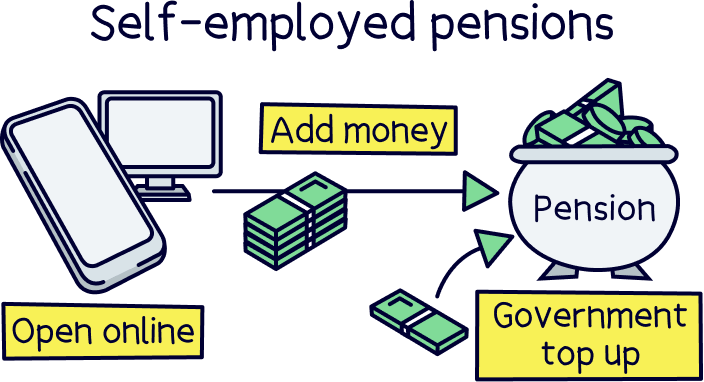
Before that, if you’re just here looking for the best pension plans for self-employed people, here they are…
PensionBee is the top option. It’s easy to use, low cost and you can pay in from your company too.
Get £50 added to your pension



PensionBee is our recommended provider – they’ve thought of everything.
Their 5 star rated app (and website) makes it easy to set up and use. You can open a brand new pension, or transfer your existing pensions across (they’ll handle all the paperwork).
Simply pick from an easy to understand range of pension plans, and that’s it, the experts manage everything from there.
It’s low cost, with one simple annual fee. The customer service is excellent, and you’ll get a dedicated account manager for any questions you might have.

And, when the time comes to retire, withdrawing from your pension is easy too.
You can also use them if you're self-employed or a company director.
Great app



A great and easy to use pension. Add money from your bank or combine old pensions into one, (they’ll find lost pensions too).
The customer service is excellent, with support based in the UK.

Beach is an easy to use pension app (and easy to set up), where you just add money and the experts handle everything. It’s all managed on your phone with a great app, and you can see your total pension pot whenever you like.
If you’ve got lost or old pensions, Beach can also find them and move them over too, so you can keep all your retirement savings in one place, and never have to worry about losing them in future.
You’ll get an automatic 25% bonus on the money you add to your pension pot from your bank account (tax relief from the government), which refunds 20% tax on your income, and if you pay 40% or 45% tax, you’ll typically be able to claim the extra back too.
The pension plan (investments) are managed by experts, who are the largest investment company in the world (BlackRock). And they consider things like reducing climate change, meaning your savings could make the world a little better in future too.
You can also save and invest alongside your pension with an easy access pot (access money in around a week), designed for general savings, with the investments managed sensibly by experts too. And money made can be tax-free within an ISA.
Fees: a simple annual fee of up to 0.73% (minimum £3.99 per month).
Minimum deposit: £25
Customer service: excellent
Pros:
Cons:
PensionBee is the top option. It’s easy to use, low cost and you can pay in from your company too.
One of the 4.5 million self-employed people in the UK? Did you know only 31% of those are actually saving into a pension (IPSE). Yikes!
You want to be part of the group saving for retirement, as you’ll need a pretty massive pension pot to give you a comfortable retirement these days.
In fact, it’s as much as £853,039 to provide a comfortable retirement income of £43,100 per year, and that pension pot is in addition to receiving the State Pension (the government pension), we’ll cover how much you’ll need, and what the State Pension is just below.
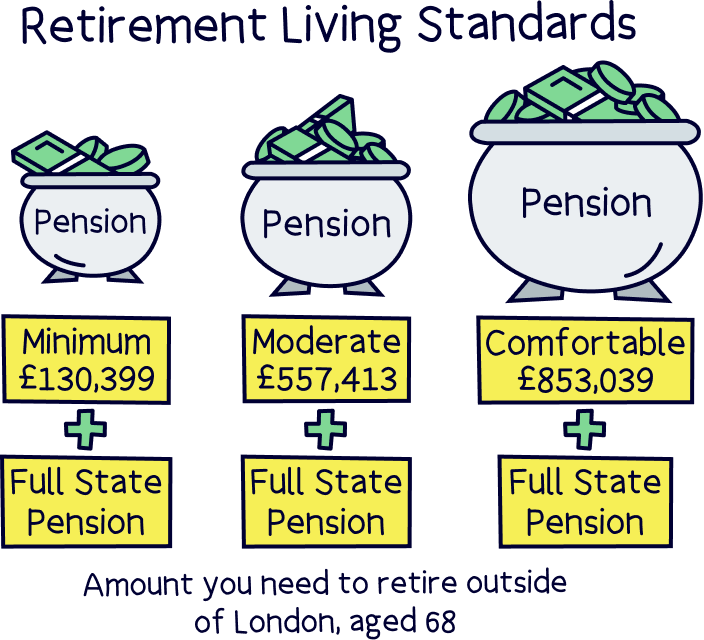
First of all, though, let’s run through how pensions work for self-employed people – as they’re quite a bit different to the pension you’d get if you were employed (called a workplace pension).
Pensions for self-employed people are called personal pensions – although you might have heard them being called private pensions…
Personal pensions and workplace pensions are both types of private pensions, meaning they are in your name, and you decide how much to save, and when to withdraw money (a pension that's private to you).
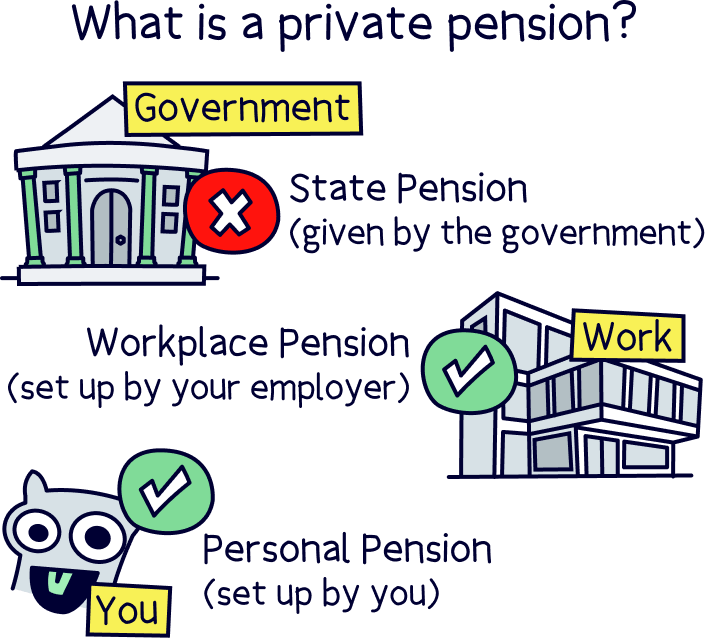
Right, let’s get into the details of personal pensions.
Personal pensions are pretty great, and very similar to what you might have had with a workplace pension. The main difference is you add money yourself directly into your pension pot, rather than it coming out of your salary. Although unfortunately, as you’re not employed, your employer won’t add any extra cash themselves (most employers will add 3% if the employee adds 5%).
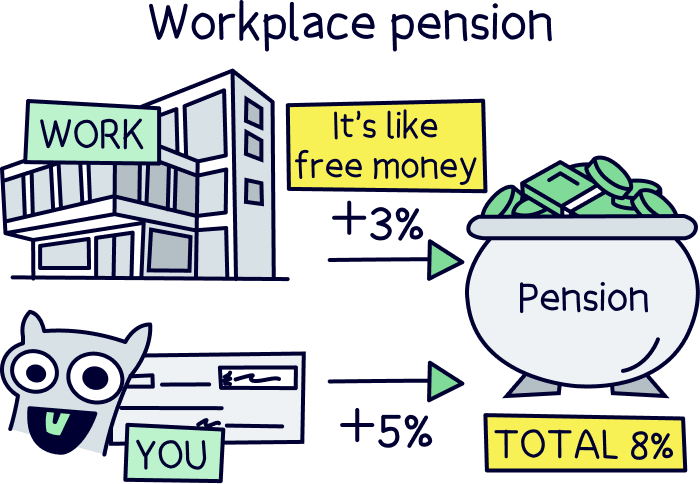
Believe it or not, but when you add money to your personal pension, the government will automatically give you a 25% bonus! Pretty great right?
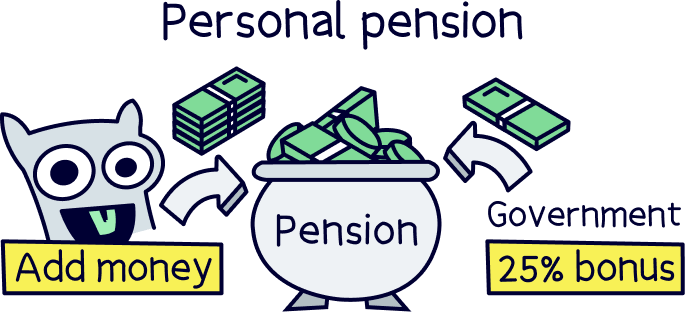
This is because pensions are meant to be tax-free and as you’re self-employed, you won’t be able to pay into your pension before you pay any tax (e.g. from your payslip) – so the bonus is to refund the tax you’ve already paid on your income (or will pay). Technically, this is called tax relief.
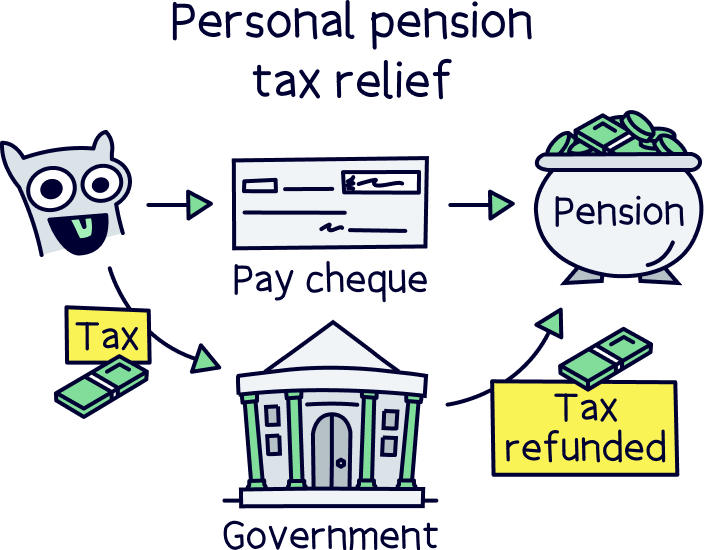
The 25% is to refund your tax paid at the 20% tax rate (sounds odd but the maths works out). You’ll also be able to claim some tax paid at 40% (higher rate tax) or 45% (additional rate tax) if you’ve paid tax at those rates too (so earning over £50,270 per year).
Money inside your personal pension will grow tax-free too – that means it can grow much bigger over time, you won’t have to pay any tax and all the paperwork that comes with it.
When it comes to withdrawing money, 25% of it will be completely tax-free, and you can even take it as a tax-free lump sum if you want to (all in one go). With the remaining 75%, you might pay Income Tax on it (just like your income now), it all depends on your income at the time.
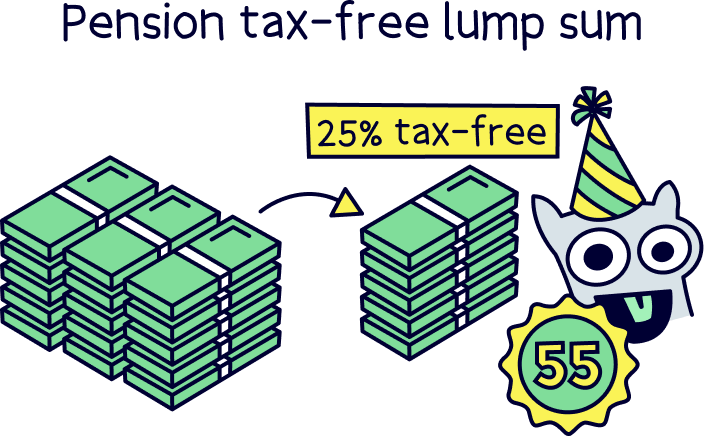
Note: you’ll only be able to withdraw your money from the age of 55 (57 from 2028).
Pensions have a fairly unique feature, whereby they are their own special thing, and don’t count towards your ‘estate’ when you sadly pass away. Your estate is all your money and possessions added together, and these count towards Inheritance Tax (which is typically eye-wateringly high at 40% on anything above £325,000).
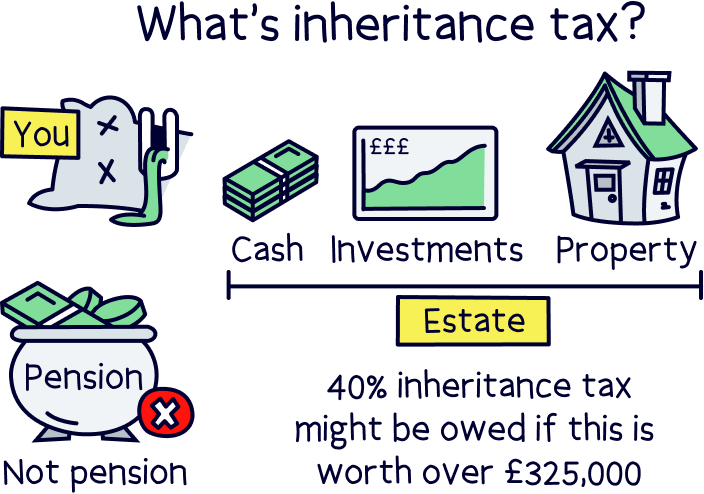
Instead, pensions can be passed on to anyone you choose (just let your pension provider know), and if you pass away before the age of 75, they won’t pay any tax at all. If you pass away after 75, they might pay Income Tax on what they withdraw (it depends on their income at the time).
In a way, it can act as a form of life insurance, or as an added boost to your life insurance policy.
Before you get too carried away and add all of your money into your pension pot, there are some limits to be aware of.
First, as we’ve mentioned, you won’t be able to access your money until you are at least 55 years old (57 from 2028). It’s for retirement after all!
Nuts About Money tip: we typically recommend leaving it to grow for as long as possible, to build up a nice big retirement income.
The second, is that you can only save as much as your total income each year, or £60,000, whichever is lower.
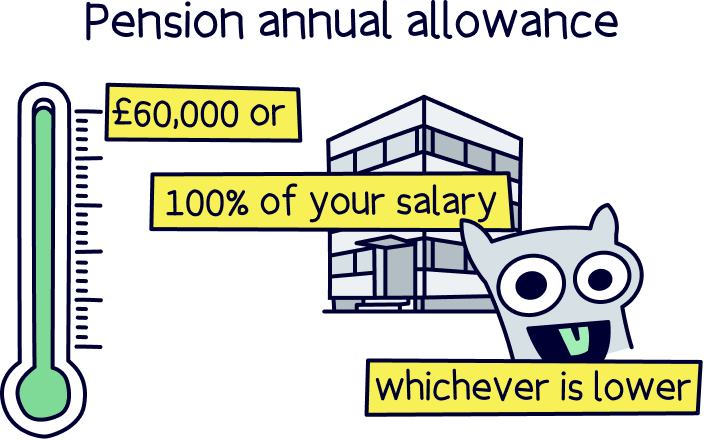
Although if you’re a limited company director, your limit is £60,000, even if you pay yourself less.
There’s actually two different types of personal pensions. There’s a regular personal pension, where the money is looked after by experts, with the aim of growing it sensibly over time. And, then there’s a self-invested personal pension, which is where the investments are managed by you.
We recommend these for most people – they’re super easy to set up and use, and you don’t need to worry about making any regular investment decisions (with pensions, your money is invested to help grow over time).
Here, the experts take care of that, all you need to do is add your money, and sometimes, pick from a very small range of easy to understand pension plans (investment options).
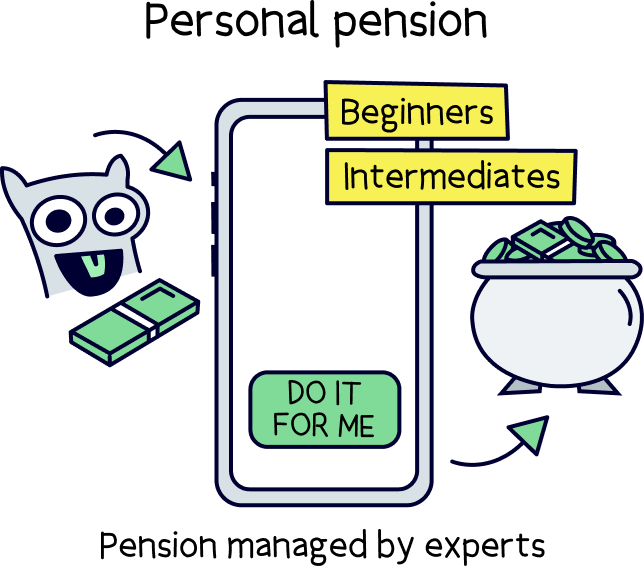
If you like the sound of these but don't know what company to use, check out PensionBee¹, it’s 5* rated, easy to use, has low fees and a great record of growing pensions over time. You’ll also get £50 added to your pension for free with Nuts About Money.
With a self-invested personal pension (SIPP), you’ll be making the investment decisions, so only recommended for those experienced in investing.
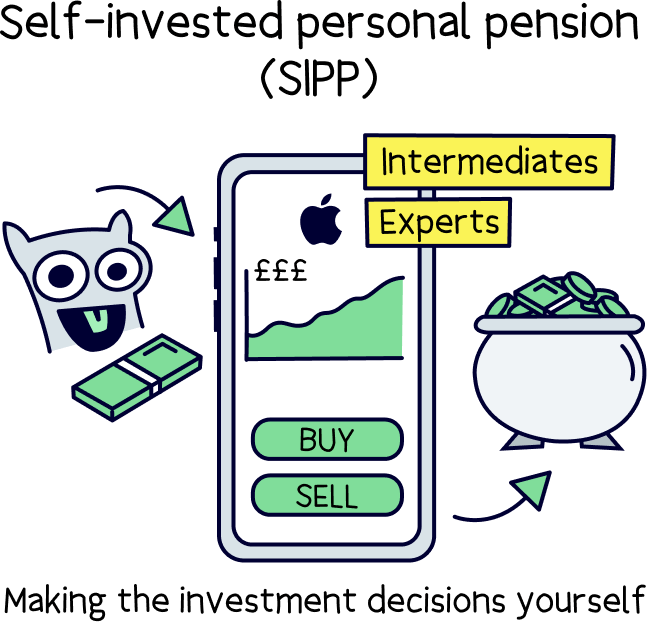
You’ll typically need to use a different pension provider to an expert managed pension, and if you’re interested in these, learn more with our guide to the best SIPP providers.
Although having said that, modern pension providers are typically SIPPs too. Confusing we know! However, they simply offer a limited range of investment options (called pension plans), where the experts handle things too. An example of these are PensionBee and Beach¹.
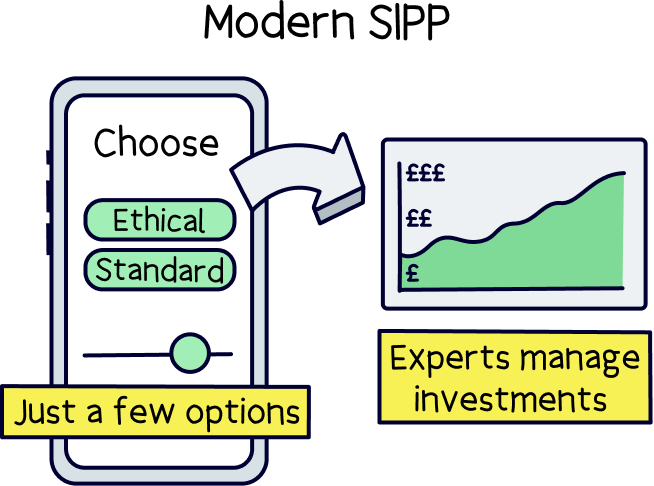
Personal pensions sound pretty great right? As a reminder, they’re often also called private pensions (but for self-employed people, that means the same thing).
Although pensions can be pretty complicated, setting one up is really quite simple! Here’s how to sort everything in just 3 easy steps:
First up, you’ll need to find a great pension provider, who’s happy to help those who are self-employed. Don’t worry though, this bit’s easy, we’ve already done the hard work for you.
Things to consider:
Our top recommendation is PensionBee¹, it’s easy to use, and you can pay in directly from your business if you want to. We also think Beach¹ is pretty great, you cab save within a pension and an ISA for general savings at the same time.
For all our top options, check out the best pension providers.
Once you've chosen a pension provider, simply select a pension plan (don’t worry, it’s not that complicated and it's not set for life, you can always change it at a later date if you want to).
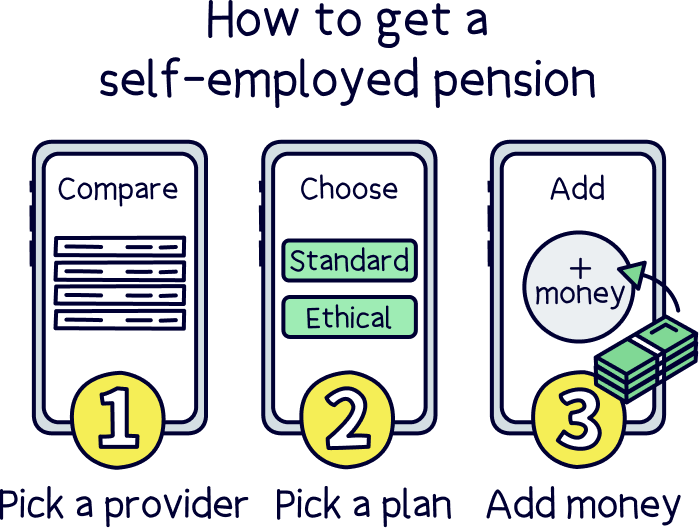
The great thing about modern pension providers is that they have a few, easy to understand options, to suit most people. And, there’s often an ethical investing option too, where your money isn’t invested in things such as fossil fuel companies.
Finally, all that’s left to do is add money and you’re good to go! We often recommend setting up a monthly savings figure if you can.
We know this can sometimes be difficult for self-employed people, where money isn’t always regular, but if you can squirrel away a bit every time you get paid, it really will add up to a lot over the years. Your future self really will be thanking you!
Got some old pensions lying around collecting dust? Perhaps from old jobs when you were employed.
Well, once you’ve set up your new personal pension, you can actually transfer your old pensions across to your new pension, often completely for free. This is called combining your pensions, or consolidating your pension.
It’s easy to do (if you pick a modern pension provider, such as our recommendations). All you have to do is let your new pension provider know the name of your old pension company. That’s it, they’ll handle the rest, and sort all the paperwork behind the scenes, your money will simply turn up on your new pension pot after a few weeks (sometimes a few months).
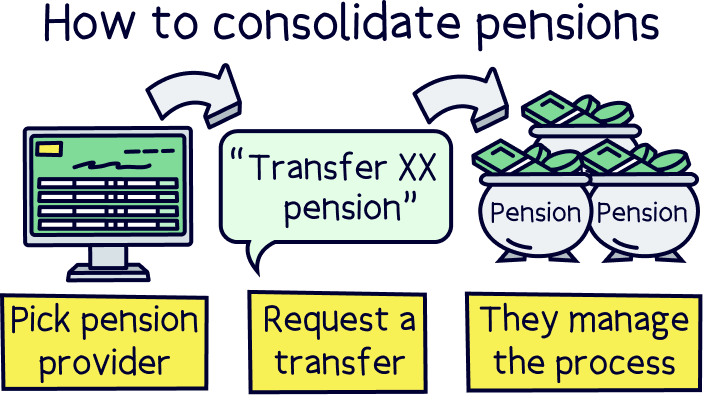
We typically recommend combining your pension, as it means you’ll never forget where your pensions are when it comes time to retire (it happens a lot), and you can potentially benefit from better pension growth, and lower fees (with a great provider).
If you’ve forgotten where your old pensions are, don’t worry. Try the government’s pension tracing service, or Gretel, a free service to find lost pensions.
We can’t stress this enough for self-employed people, your pension is super important, make sure you have a pension set up and are paying into it – these days, you’ll need a hefty pension pot to have a comfortable retirement.
There’s 3 different levels of retirement income in the UK, called ‘retirement standards’, which are minimum, moderate and comfortable. Minimum covers the basics you’ll need for essentials, such as food. Moderate gives you a bit more, and a short holiday each year, and comfortable is more for food, a longer holiday and a somewhat newish car.
Here’s how much you’ll need to save for each retirement standard, and how much income that will provide in retirement. By the way, this includes receiving the State Pension (the government pension) – so you’ll need a private pension totalling these numbers in addition to receiving the State Pension (more on that below).
Yikes! It’s a lot isn’t it? You can see why we keep banging on about getting your pension sorted, and paying as much as you can into it.
Don’t panic though, pensions are pretty special, and have lots of benefits to help your money grow once it’s in there – and the sooner you start saving, the bigger it can grow.
Being self-employed, and using a personal pension, every time you add money to your pension, you’ll get a massive 25% bonus from the government, added automatically. On top of that, your money grows tax-free too, so it can grow much quicker over time (you might pay tax on some of it when you start to withdraw it).
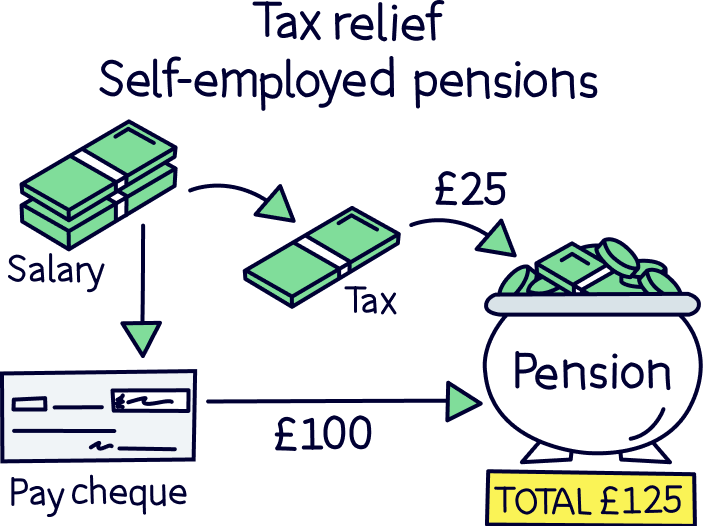
And as your money grows, it benefits from something called compound interest, which is where the money you make, starts to make money too, and this snowballs over and over.
Imagine you started with £10,000 in your pension, and were able to save £220 per month, and it also increased by 7% per year (as the experts are handling things). After 25 years, your pension pot would have grown to a massive £235,470!
And after another 10 years, it would have grown to £511,294. The next year after that it would have grown by £35,791 in a single year.
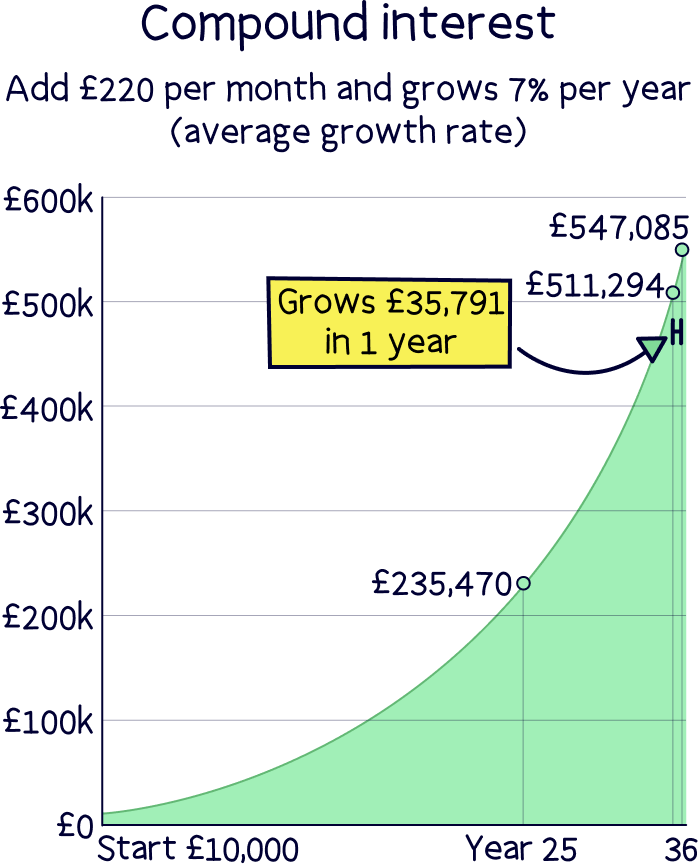
Can you see how getting to that moderate or comfortable retirement might be achievable now? The sooner you save, and the more you save early, will mean a much more secure retirement. No one wants to be working forever right?!
We've mentioned the State Pension a few times now. This is the pension you’ll get from the government when you reach State Pension age (currently 66), and you’ll only get it if you pay at 10 years worth of National Insurance contributions during your working life, and 35 years to get the full amount.
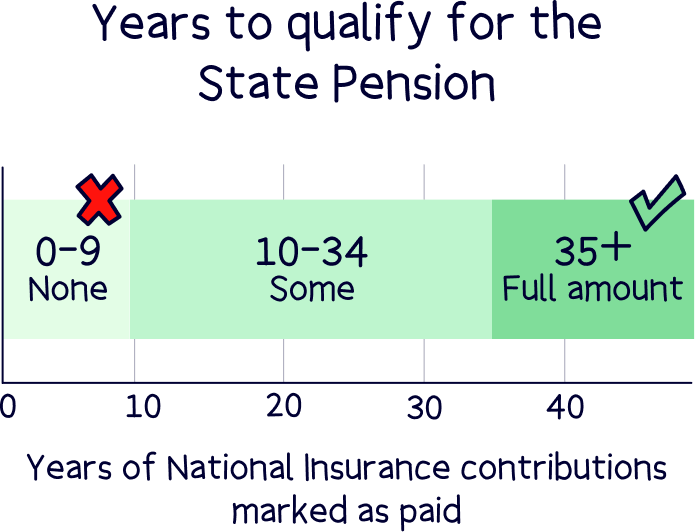
However, the full amount is just £230.25 per week, which is £11,973 per year. So it doesn’t cover the minimum amount needed to cover the essentials in retirement.
Don’t rely on the State Pension, especially being self-employed, it’s not enough to live on – make sure you boost your pension pot by setting up your own personal pension.
As a reminder, check out PensionBee¹, it’s easy to use, low cost and has a great track record of growing pensions over time.
If you’re a sole trader, which means working for yourself directly, rather than through a limited company, the world’s your oyster when it comes to personal pensions – you can pretty much pick any personal pension you like as you’ll be paying money in directly from your personal bank account.
You’ll benefit from the massive 25% government bonus on all of your pension contributions too.
As a recap, if you’re not sure which pension provider to go for, check out the best private pensions for the self-employed.
If you’re a limited company director, which is where you effectively work for yourself through a registered company, rather than directly yourself, you’ve got a few options when it comes to your pension.
The first, is that you could simply pay into a personal pension directly from your personal bank account, where you’ll get the 25% government bonus on all of your contributions (and your money will grow tax-free too).
The second is that you could pay into your pension directly from your limited company. This way, your pension contributions will actually become a business expense (a cost to the company), and therefore reduce the amount of profit your company makes – which in turn, reduces your tax bill (Corporation Tax), which can be anywhere from 19-25% depending on how much your company makes. It's a no-brainer right?
Company directors also benefit from being able to pay in as much as £60,000 per tax year, even if they pay themselves less (the pension annual allowance limit is typically either your income, or £60,000, whichever is lower). To do this, it simply needs to be paid from the company bank account.
Finally, you could also benefit from reducing your National Insurance contributions bill. To do this, instead of paying yourself more as a salary (to then put into your pension), you reduce the amount you pay yourself via your salary.
With that in mind, we also recommend PensionBee¹ for limited company directors – and not only is it easy to use, has low fees and a great record of growing pensions, but you can also pay in directly from your limited company, and it’s super easy to do too.

Nuts About Money tip: learn more with our guide to the best pensions for limited company directors.
Sorry to put a downer on things, but when you sadly pass away, your pension can have some fairly good benefits for your family.
As a reminder (it's really important), instead of becoming part of your ‘estate’, which is all of your money and possessions added together and counted towards Inheritance Tax (which can be 40% on anything above £325,000), your pension is completely separate.
With your pension, if you pass away before the age of 75, it passes to whoever you decide (such as your family), completely tax-free. So, it can act as a form of life insurance for your family too.
If you pass away over 75, whoever receives your pension will pay Income Tax on it, and the rate will depend on their income at the time (and how much they choose to withdraw and when).
Once you’re all set up and building your pension pot, here’s what happens when you retire as a self-employed person.
From the age of 55 (57 from 2028), you’ll be able to start withdrawing from your personal pension if you want to – although we recommend leaving it where it is until you really need it, so it can hopefully keep growing over time into an even bigger pension pot.
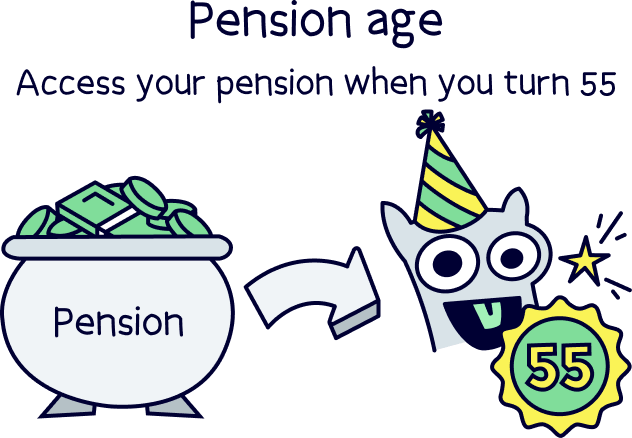
When you do withdraw from it, 25% will be tax-free, and you can take this as a tax-free lump sum if you like (all in one go). With the remaining 75%, you might pay Income Tax on it (the same as your income now), it all depends on your income at the time.
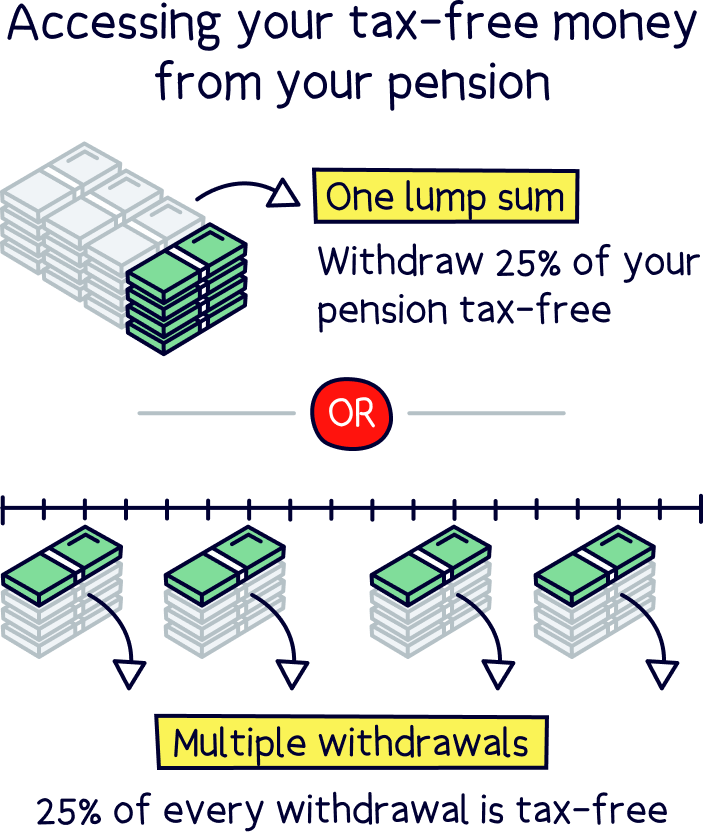
With your personal pension, you can either decide to keep it where it is (in your pension pot), so it can keep growing, and simply withdraw from it as and when you like, which is called pension drawdown (and becoming very popular since the law changed in 2015 to allow this).
Or, you can trade in your pension to buy a guaranteed income for the rest of your life (or a set number of years), which is called a pension annuity. Or, you can do a bit of both. The choice is yours – although it can be worth speaking to a financial advisor when the time comes to review your options.
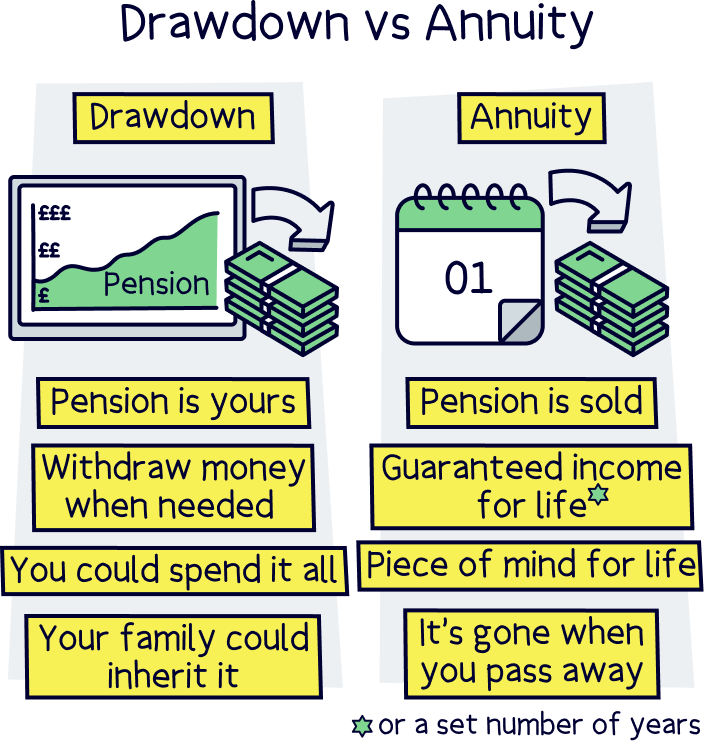
To learn more about both of these options, here’s our guide to pension drawdown vs annuity.
Finally, if you’ve made enough National Insurance contributions over your lifetime (at least 10 years, but 35 years for the full amount), you’ll get the State Pension when you reach the age of 66 – which can be a handy boost to your retirement income (but not to be solely relied on).
There we have it. Everything you need to know about self-employed pensions, and which pensions you can get as a self-employed person.
Being self-employed has sooo many benefits, and totally worth it – as you know, being your own boss can be life changing. The big downside is you’ll have to manage your finances, and your future finances – but that’s okay, you can delegate that to the real pensions experts (if you opt for a great, modern pension provider).
If you’re not sure where to find one of these great providers, fear not, we’re done the hard work for you…
Our top recommendation is PensionBee¹, it’s easy to use, has low fees and a great record of growing pensions over time – and you can pay in directly from a limited company (if you have one), which can mean even more tax saving benefits.
You’ll also get £50 added to your pension with Nuts About Money.
There’s also Moneyfarm¹, which is great too, and has experts on hand to give advice if you’d like it. For all the top options, check out the best private pensions.
And that’s it. Good luck building a nice big pension pot for your future self!
PensionBee is the top option. It’s easy to use, low cost and you can pay in from your company too.
PensionBee is the top option. It’s easy to use, low cost and you can pay in from your company too.
We’d love to hear from you, and it will help others too.
PensionBee is the top option. It’s easy to use, low cost and you can pay in from your company too.